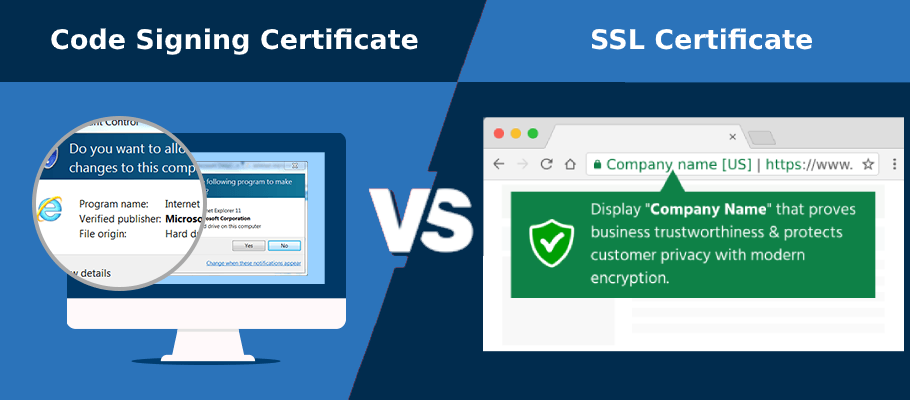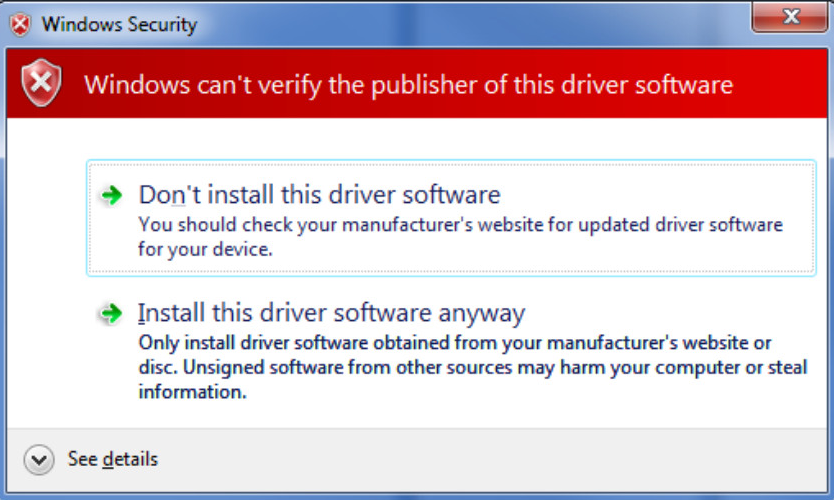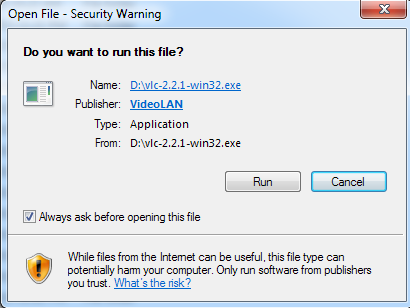Code Signing Certificate vs SSL Certificate: What’s the Difference?

Learn about the Differences Between a Code Signing Certificate and an SSL Certificate
If you’re into web or software development and you’re looking to secure your web presence, then there’s a possibility you might be asking yourself: is a code signing certificate the same as an SSL/TLS certificate? If so, let’s explore the similarities and dissimilarities between the two:
What is a Code Signing Certificate?
A code signing certificate works like a guarantee that the code of a program, application, or any software you downloaded has not been tampered with since it was signed by the publisher, which is done with the help of a digital signature and by hashing the digital signature with the software.
A code Signing certificate provides a method of putting a digital signature on software or any executable file so its authenticity and integrity can be verified at the time of installation or execution. You can say it’s like a wax seal which guarantees to its recipient who the author is and that it has not been opened or tampered with since it was signed.
To put it another way, a certificate authority issues a validation to show that a software developer or a publisher’s code is genuine, that it’s theirs – if the client trusts that organization, they can also trust the code. You can say that it’s a type of protection to the user of the code.
So, whenever a user tries to download any software which is not signed, a warning sign will be generated like below:

However, signed software will not face such issues. Likewise, if it’s signed using EV (Extended Validated) Code Signing Certificate, then it will also bypass Microsoft SmartScreen messages like this instantly:

Files signed using standard code signing sometimes take time to develop a reputation with Microsoft Smart Screen.

What is an SSL/TLS Certificate?
An SSL/TLS Certificate is a digital file, which is used for SSL (Secure Socket Layer) or TLS (Transport Layer Security). It’s used to fulfill two functions:
- Assist with authentication and verification of the identity of a host or website.
- Enables encryption of information which is exchanged between the user’s browser and a website server.
Failing to install an SSL/TLS Certificate leads to a warning message similar to the code signing certificate, but it’s shown in the web browser, whenever any user tries to access the site:


In the left image shown above, an SSL/TLS Certificate is installed and a secure padlock shows next to the URL. In the right image, the secure padlock is missing and “Not secure” is indicated, which means an SSL/TLS certificate is not installed.
What are the Similarities Between a Code Signing Certificate and an SSL/TLS Certificate
From one perspective, you can say that a Code Signing Certificate is like an SSL/TLS Certificate, as both are used to sign data to prove that the data (web page content or software package) is coming from the “subject” of the certificate. Here are a few of the similarities:
- Like SSL/TLS certificates, code signing certificates are also X.509 certificates and use PKI (Public Key Infrastructure.)
- Failure to install an SSL/TLS certificate or a code signing certificate leads to a security warning.
- Vetting of an applicant by a certificate authority before issuance is required for both types of certificates.
- The reason behind getting any of these certificates is to protect users from becoming victims of any cybercrime.
The more we dig into these two types of certificates, though, the more we discover: “never the twain shall meet.”
What are the Differences Between a Code Signing Certificate and an SSL/TLS Certificate?
| Code Signing Certificate | SSL/TLS Certificate | |
|---|---|---|
| Used For |
It’s used for securing:
| It’s used for securing a website. |
| Object Identifier (OID) | For code signing, the Object Identifier (OID) is 1.3.6.1.5.5.7.3.3 |
For SSL/TLS certificates, the Object Identifier (OID) is:
|
| Users | Software developers or publishers | Owners of websites |
| Validation Types |
There are two different types of validation:
|
There are three different types of validation:
|
| Encryption | It does not encrypt the software, but hashes the digital signature of the software publisher, and the code. Hashing is like putting a seal on the software code, similar to a wax seal on a letter. | It encrypts the data transferred between the website server and the user’s web browser. |
| Assurance | Code signing assures the integrity of the code. | SSL/TLS Certificate ensures the security of an online transaction done between the user’s browser and a server. |
| Once the Certificate Expires | If your software was signed using timestamping service, it’s possible to verify its integrity and validity even after certificate expiration. | An SSL/TLS certificate becomes invalid and shows a warning message to users once it expires. |
| Validity Period | Up to three years. | Up to two years. |
| Popular Certificate Authorities | Symantec, Thawte, Comodo/Sectigo | Symantec, Thawte, GeoTrust, DigiCert, RapidSSL, Comodo/Sectigo |
| Other Features | Provides private key in an external USB, which works like a two-factor authentication at the time of signing the software. | Dynamic site seal for certain Domain Validated and Organization Validated and Extended Validated SSL/TLS Certificate. |
| Warranty Amount | Only two certificate authorities, Symantec and Thawte, give a warranty. | Mostly, all the branded certificate authorities provide warranty for the paid SSL/TLS certificates. |
| Read More | Read More |
Note: Object Identifier or OIDs are an identifier mechanism standardized by the ISO/IEC and ITU (International Telecommunications Unit) to name any concept or object with a persistent name that is globally unambiguous.
To sum up, we can say that the rising trend of software and website security makes it mandatory to use a digital signature as well as SSL protocol to give maximum protection to the users. As shown above, both certificates are important in their respective manners.
Note: Object Identifier or OIDs are an identifier mechanism standardized by the ISO/IEC and ITU (International Telecommunications Unit) to name any concept or object with a persistent name that is globally unambiguous.

Cheap Code Signing Certificate from Trusted SSL Certificate Authorities from Comodo, Sectigo, and DigiCert


